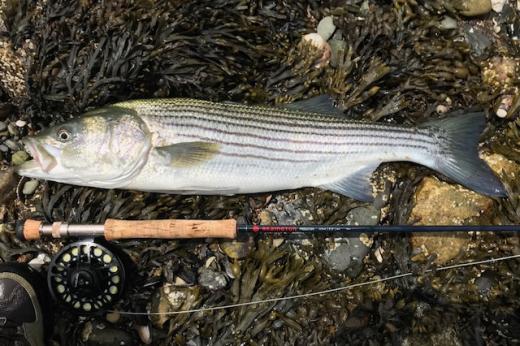Boston Harbor Striped Bass on The Fly
By John Lefeber
For the Boson angler who doesn't have time to sit in Cape Cod traffic, there are a plethora of waterfront options in greater Boston for easy wading and some of the best Striped Bass fishing in Massachusetts. It may not be the pristine coastline of the Cape or the North Shore where you won’t see another angler for miles, but there is definitely something to be said for lifting a keeper Striper out of the water to cheers from a crowd of curious joggers who gathered to watch your fight. For a Bostonian who has a weekend day to spend on the water or just a couple of hours after work, Boston Harbor will fill your fishing needs. With the Fall run right around the corner, it’s time to touch up on our Striper strategies for the area.
The Where: Even though most of Boston’s coast holds fish, not all of it is fishable. Go downtown or to the Seaport on a busy Saturday and see for yourself. There are a few characteristics to look out for when searching for a spot. Any area with current and/or shallow water in close proximity to deep water will hold Striped Bass. Outgoing tides will create better currents and easier wading conditions than the incoming. NOAA has all of their ocean charts online for free. These are an incredibly valuable resource to the Striper angler. Some of the classic areas to fish in Boston Harbor are Deer Island, South Boston/Castle Island, and Squantum Point. All are easily accessible by car and have parking, just get used to Interstate 93 and Route 1! See map below.
The Gear
Rod: 9 foot 8/9 wt. Most schoolies can be caught on lesser rods but if you want to be able to cut through wind properly (especially in the Fall), a 9wt will do the trick. Also, the extra weight helps when you hook into a keeper bass, which there are many of in Boston Harbor.
Line: Cold-water intermediate sink line. Some saltwater fly fishers like to use floating line but if you are looking or an all-purpose line an intermediate sink will work best. It will be able to get your fly below any current or waves you are dealing with but also be able to suspend flies properly in relatively shallow water. Floating line can’t get below current and full sink line is too extreme for most wading situations. Using a sinking line when wade fishing you will end up losing more flies on rocks than you will catch fish. More advanced anglers will carry all options on them and change as needed.
Tippet: Don’t be afraid to go heavy. 16lb test seems to work best. It is heavy enough to be able to put your weight into but not as inconspicuous as 20lb. Fluorocarbon is a plus but not necessary in Boston Harbor water.
Boots: Because of the rocky coast and the tidal swing of the harbor, either studded or felt bottom wading boots are a must. Standard rubber soled boots which are fitting for a sand flat will make Boston Harbor a slip-and-slide, leaving you with ripped waders and sore buttocks. Although this writer has done it, it’s not recommended.
The Flies: During the dog days of summer, Stripers can be surprisingly picky, this changes during the Fall run. Even the most sophisticated feather studying bass turns into a bait busting predator when water temperatures start to drop. Feeding patterns are more similar to their Spring run north but to an extreme. Bass blitzing large schools of bait similar to bluefish feeding is characteristic of the Fall. During this time they are primarily feeding on peanut bunker. Due to their veracity and the bait available, fly section is relatively simple. Any light colored baitfish pattern similar to a Lefty’s Deceiver or Clouser Minnow in the 3-5 inch range will work well. The wider the profile in the Fall, the better. Feel free to add an extra stack of bucktail to the top of your deceiver patterns to get this result.
Techniques: When fishing a heavy current, it’s best to dead drift the fly, almost similar to nymphing but with longer casts. Just a few strips of the line to keep the line tight and to add a little action to the fly will do. This technique mimics a wounded baitfish that has been caught up in the current, exactly what bass are looking for in these situations. When covering open water, long, relatively slow, consistent strips work best. Any inconsistencies in strips may turn off some fish and are to be avoided. When lucky enough to be in a blitz, where a school of Stripers is actively feeding on a large school of bait on the surface, fast strips are most effective to bring attention to your fly rather than the thousands of naturals in the water. In these situations it’s not a bad idea to try a double handed retrieve with the rod tucked in your armpit.
Final Note: Striped Bass are a finite resource. Unless we conserve and protect them the same way we do Trout and other species, we will lose them. Striped Bass have a surprisingly long lifespan and take years to mature into the breeding population. This makes their stocks especially vulnerable to human threats. An average keeper class fish (28in) is over 8 years old and the bigger the fish, the more important it is to the breeding population. Please, practice catch and release with these fish. The fish you release in the Fall run are the same ones which will come back next spring to tighten our lines and bend our rods.


